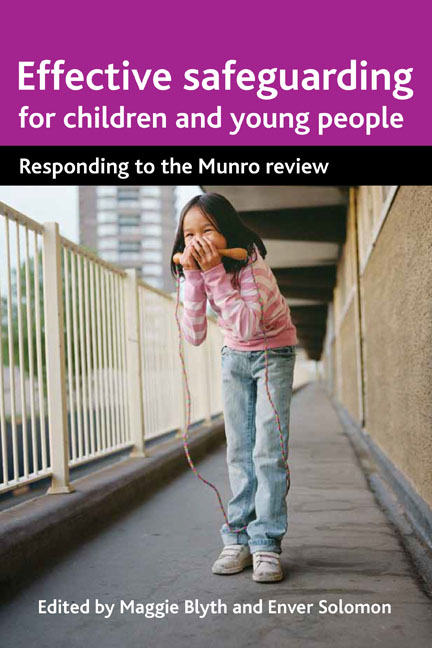Book contents
- Frontmatter
- Contents
- List of abbreviations
- Notes on contributors
- Acknowledgements
- Foreword
- one Early intervention
- two Local safeguarding children boards: faith, hope and evidence
- three The child's voice in the child protection system
- four Parental mental health, risk and child protection: what does Munro mean to child protection and adult mental health?
- five Adolescent-to-parent abuse and frontline service responses: does Munro matter?
- six Older children and the child protection system
- seven Serious case review
- Index
two - Local safeguarding children boards: faith, hope and evidence
Published online by Cambridge University Press: 07 September 2022
- Frontmatter
- Contents
- List of abbreviations
- Notes on contributors
- Acknowledgements
- Foreword
- one Early intervention
- two Local safeguarding children boards: faith, hope and evidence
- three The child's voice in the child protection system
- four Parental mental health, risk and child protection: what does Munro mean to child protection and adult mental health?
- five Adolescent-to-parent abuse and frontline service responses: does Munro matter?
- six Older children and the child protection system
- seven Serious case review
- Index
Summary
Introduction
Since their creation for England and Wales in the 2004 Children Act, local safeguarding children boards (LSCBs) have been invested with hope by policymakers and inquiries. Government ministers have expressed optimism about the potential of LSCBs to make a difference in promoting accountability for practice, generating learning from practice, and monitoring the effectiveness of work with children and their families (DfES, 2007; DfE, 2011).
This faith has been reinforced by inquiries. Laming (2009) recommended strengthening LSCBs through clarifying their relationship with, and distinctiveness from, children's trusts, improving scrutiny and challenge through the production of annual reports and the introduction of greater independence for serious case review (SCR) panel chairs and overview report writers, and by the attendance of senior decision-makers. Munro (2011a, 2011b) does not disturb this trend. She regards LSCBs as uniquely placed to take a holistic approach to child protection, a role she argues is even more important in a tight fiscal climate. She argues that LSCBs have a key role in promoting and supporting learning, identifying and challenging poor practice, monitoring outcomes, and advising on service development to reduce gaps and duplication in provision.
Researchers too have endorsed mechanisms, such as LSCBs and children's trusts, for facilitating interagency cooperation and developing mutual and collective accountability in respect of safeguarding children (O’Brien et al, 2006). This calm is, however, occasionally disturbed by more critical perspectives (Parton, 2006; Chief Inspectors, 2008; Watson, 2010), raising the spectre that LSCBs might be active without contributing much to child protection and children's safeguarding more broadly. They are viewed as adding to unnecessary bureaucracy, duplicating the roles and responsibilities of other collaborative mechanisms, such as children's trusts, and thereby consuming expensive staff and financial resources. Doubts are expressed about their capacity for generating positive outcomes for children and families.
So is this faith and hope justified? Have LSCBs promoted positive outcomes and enhanced explanatory and responsive accountability (Leat, 1996) for the work of safeguarding children? Do they have sufficient statutory and positional authority to do so? Have they facilitated professionals and organisations working together, strategically and operationally, and do they have sufficient reach in terms of resources to do this?
- Type
- Chapter
- Information
- Effective Safeguarding for Children and Young PeopleWhat Next after Munro?, pp. 25 - 50Publisher: Bristol University PressPrint publication year: 2012

